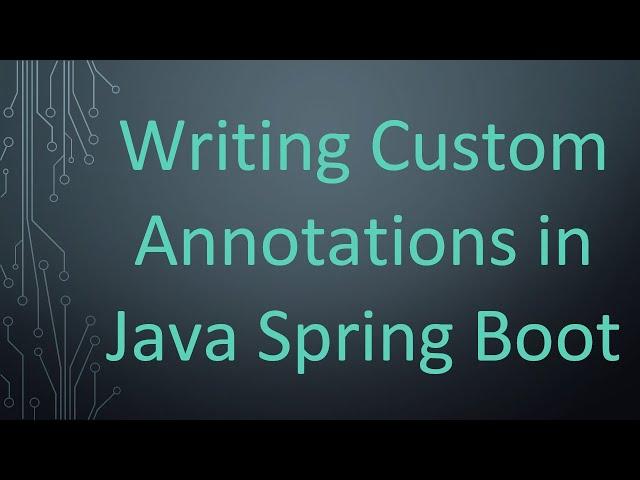
Writing Custom Annotations in Java Spring Boot
Disclaimer/Disclosure: Some of the content was synthetically produced using various Generative AI (artificial intelligence) tools; so, there may be inaccuracies or misleading information present in the video. Please consider this before relying on the content to make any decisions or take any actions etc. If you still have any concerns, please feel free to write them in a comment. Thank you.
---
Summary: Learn how to create custom annotations in Java Spring Boot to simplify repetitive tasks and enhance code readability and maintainability. This guide covers the steps to define, apply, and process custom annotations in a Spring Boot application.
---
When developing applications in Java Spring Boot, you often encounter situations where you need to perform repetitive tasks or apply specific configurations across your codebase. Custom annotations offer a powerful way to encapsulate such behaviors and apply them consistently throughout your code. In this guide, we'll explore how to create custom annotations in Java Spring Boot to streamline your development process.
Defining Custom Annotations
To define a custom annotation in Java Spring Boot, you can use the @interface keyword followed by the annotation name. For example:
[[See Video to Reveal this Text or Code Snippet]]
In this example, we've created a custom annotation named CustomAnnotation with a single element value.
Applying Custom Annotations
Once you've defined your custom annotation, you can apply it to methods, classes, fields, or other elements within your Spring Boot application. For instance:
[[See Video to Reveal this Text or Code Snippet]]
Here, we've applied the CustomAnnotation to the myMethod() within the MyService class.
Processing Custom Annotations
To process custom annotations in Java Spring Boot, you can leverage reflection and AOP (Aspect-Oriented Programming). A common use case is to create an aspect that intercepts methods annotated with your custom annotation and performs specific actions. For example:
[[See Video to Reveal this Text or Code Snippet]]
In this aspect, the processCustomAnnotation() method intercepts any method annotated with CustomAnnotation. It retrieves the annotation's value and performs actions accordingly before proceeding with the method execution.
Conclusion
Custom annotations in Java Spring Boot provide a flexible mechanism to encapsulate and reuse common behaviors or configurations throughout your application. By defining, applying, and processing custom annotations, you can enhance code readability, maintainability, and scalability. Whether you're simplifying repetitive tasks or adding cross-cutting concerns, custom annotations offer a valuable tool for Java Spring Boot developers.
---
Summary: Learn how to create custom annotations in Java Spring Boot to simplify repetitive tasks and enhance code readability and maintainability. This guide covers the steps to define, apply, and process custom annotations in a Spring Boot application.
---
When developing applications in Java Spring Boot, you often encounter situations where you need to perform repetitive tasks or apply specific configurations across your codebase. Custom annotations offer a powerful way to encapsulate such behaviors and apply them consistently throughout your code. In this guide, we'll explore how to create custom annotations in Java Spring Boot to streamline your development process.
Defining Custom Annotations
To define a custom annotation in Java Spring Boot, you can use the @interface keyword followed by the annotation name. For example:
[[See Video to Reveal this Text or Code Snippet]]
In this example, we've created a custom annotation named CustomAnnotation with a single element value.
Applying Custom Annotations
Once you've defined your custom annotation, you can apply it to methods, classes, fields, or other elements within your Spring Boot application. For instance:
[[See Video to Reveal this Text or Code Snippet]]
Here, we've applied the CustomAnnotation to the myMethod() within the MyService class.
Processing Custom Annotations
To process custom annotations in Java Spring Boot, you can leverage reflection and AOP (Aspect-Oriented Programming). A common use case is to create an aspect that intercepts methods annotated with your custom annotation and performs specific actions. For example:
[[See Video to Reveal this Text or Code Snippet]]
In this aspect, the processCustomAnnotation() method intercepts any method annotated with CustomAnnotation. It retrieves the annotation's value and performs actions accordingly before proceeding with the method execution.
Conclusion
Custom annotations in Java Spring Boot provide a flexible mechanism to encapsulate and reuse common behaviors or configurations throughout your application. By defining, applying, and processing custom annotations, you can enhance code readability, maintainability, and scalability. Whether you're simplifying repetitive tasks or adding cross-cutting concerns, custom annotations offer a valuable tool for Java Spring Boot developers.
Тэги:
#how_to_write_custom_annotations_in_java_spring_bootКомментарии:
Как не странно, но это интро.
Jolikol
KRONSHTADT 1921. Episode 1. English Subtitles. Russian History.
Russian History. Films & Show
▶️ Не того поля ягода 1 и 2 серия - Мелодрама | Фильмы и сериалы - Русские мелодрамы
Кинокомпания «Русское»
【第3弾】東海オンエア隠れた面白名シーン集3【マイナー名シーン厳選300】
東海ランキング【公認】
THE SMART MONEY WOMAN S2 EPISODE 2 | LATEST NIGERIAN MOVIE | OSAS IGHODARO ESO DIKE TONI TONES
Azuwa Studios (fka Smart Money Arese)
УДОБНЫЙ карпфишинг! НОВЫЙ шатер SOLAR SP Cube MK2 ОБЗОР
CarpTimeVideo / карпфишинг
Turning Experience into Knowledge
Adan Khan

























